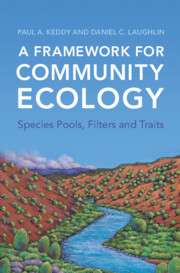Book contents
- A Framework for Community Ecology
- A Framework for Community Ecology
- Copyright page
- Contents
- Preface
- 1 A General Framework for Community Ecology
- 2 Filters
- 3 Species Pools
- 4 Traits
- 5 Trait–Environment Interactions
- 6 Functional Groups
- 7 Predictive Models of Community Assembly
- 8 Prospects and Possibilities
- References
- Index
4 - Traits
Published online by Cambridge University Press: 18 November 2021
- A Framework for Community Ecology
- A Framework for Community Ecology
- Copyright page
- Contents
- Preface
- 1 A General Framework for Community Ecology
- 2 Filters
- 3 Species Pools
- 4 Traits
- 5 Trait–Environment Interactions
- 6 Functional Groups
- 7 Predictive Models of Community Assembly
- 8 Prospects and Possibilities
- References
- Index
Summary
It is important to be able to name the plants and animals in one’s environment, but knowing the names does not in and of itself advance the study of ecology. Frank Rigler argued that the species-oriented approach to studying ecology is intractable simply because of the time it would take to obtain enough information on each species to generalize to the community scale. Life on Earth can be named (or classified) in two complementary ways, using phylogeny and functional traits. Trait matrices provide the raw material for trait-based ecology. Compilations and screening are two distinct sources of data for trait matrices. Compilation of traits across studies is an important way of generating data for global-scale synthesis. Screening traits of local communities in the field or under standard conditions is the most effective way of generating quality data for local communities.
Keywords
- Type
- Chapter
- Information
- A Framework for Community EcologySpecies Pools, Filters and Traits, pp. 125 - 164Publisher: Cambridge University PressPrint publication year: 2021

